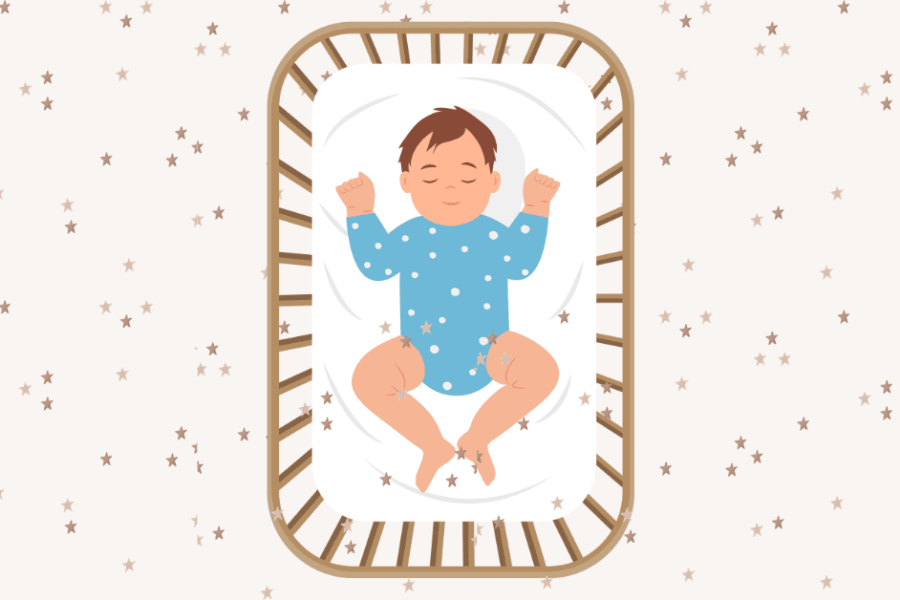As a sleep consultant, I’m here to help you create a haven of tranquility for both you and your little one. Ensuring safer sleep not only fosters peace of mind but also dramatically lowers the risk of sudden infant death syndrome (SIDS).
Please note, according to The Lullaby Trust around 89% of SIDS happen when a baby is 6 months or less, 3 months being the most vulnerable.
For a secure sleep environment, I recommend following these essential guidelines until your baby reaches 12 months of age or even longer if they arrived prematurely.
By making these vital adjustments, you’ll greatly diminish the chances of:
- Sudden Infant Death Syndrome (SIDS)
- Suffocation
- Strangulation
- Other unexplained sleep-related incidents

Babies Sleep Safe Guide
Sleeping on Back
Always lay your baby on their back for sleep. If they happen to roll onto their stomach / side, gently position them back. This helps reduce SIDS by 6x compared to sleeping on their side or front.
Keep Space Clear
Ensure there are no soft items in the baby’s sleeping area, including pillows, stuffed toys, quilts, thick blankets, mattress toppers, fur-like materials, and loose bedding like non-fitted sheets or blankets. Best practice is keeping the crib clear of all objects.
Mattress and Bedding
Use a firm, flat, non-inclined sleep surface to reduce the risk of suffocation or wedging/entrapment. Keep soft objects, such as pillows, pillow-like toys, quilts, comforters, mattress toppers, fur-like materials, and loose bedding, such as blankets and non-fitted sheets, away from the infant’s sleep area.
Ensure there are no soft items in the baby’s sleeping area, including pillows, stuffed toys, quilts, thick blankets, mattress toppers, fur-like materials, and loose bedding like non-fitted sheets or blankets.
No Narcotics
Avoid alcohol, marijuana, opioids, and illicit drug use, cigarette smoke and nicotine exposure during pregnancy and after birth. Around 60% of SIDS can be prevented if no smoke was exposed to the baby.
Set the Right Room Temperature
Avoid your baby overheating and head covering in infants. Ideal temperature ranges from 16 to 20 degrees celsius or 62 to 68 degrees Fahrenheit. At most, a baby should only wear one more layer of clothing than an adult would wear to be comfortable.
Breast Feeding
Feeding of human milk is recommended, as it is associated with a reduced risk of SIDS.
Pacifier Use
Using a pacifier helps keep the tongue forward in the mouth, keeping the airway clear. Offer the pacifier after one month of age, once breastfeeding has been established. Only offer during naps or nighttime sleep. It does not need to be reinserted once the infant falls asleep.
Sleeping with Parents
It is recommended that infants sleep in the parents’ room, close to the parents’ bed, but on a separate surface designed for infants, The recommended timeframe is 12 months with a minimum of 6.
After this, a baby can be moved to their own room. Please ensure to keep a monitor / camera on at all times. It is still advisable to check on the baby.
Swaddling Vs. Sleeping Bag
Swaddles are advised through 8 weeks of age, as long as baby is on their back and the swaddle does not overheat baby. When baby exhibits signs of starting to roll, the swaddle must stop. There is a high risk for death if a swaddled infant is placed in swaddle and rolls over. Sleeping bag then becomes more suitable.

Further SIDS Prevention Tips
- Babies should not sleep unsupervised in car seats, strollers, swings, or infant carriers, as these environments pose a risk of asphyxiation, particularly for infants under 4 months old. Avoid placing car seats in the crib.
- Engage infants in supervised, awake tummy time to promote development and reduce the likelihood of positional plagiocephaly.
- Ensure the crib is positioned away from curtains, cords, or blinds that could pose a hazard. Avoid using crib tents.
- Before allowing a baby to stay on their stomach, ensure they can roll in both directions.
- Pregnant individuals are encouraged to receive regular prenatal care.
- It is advised to follow the immunisation schedule recommended by the AAP and the CDC for infants.
- Avoid using commercial products that do not align with safe sleep guidelines.
- Do not rely on home cardiorespiratory monitors as a strategy for reducing the risk of SIDS.

